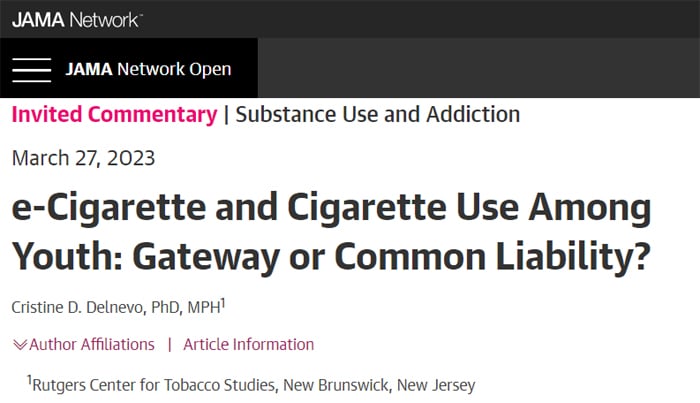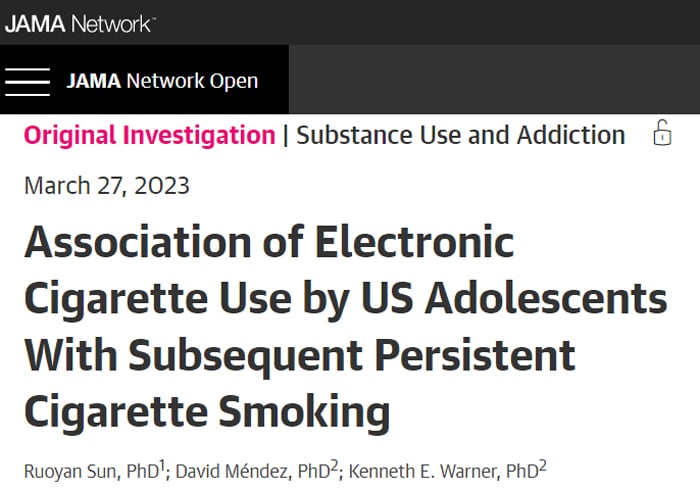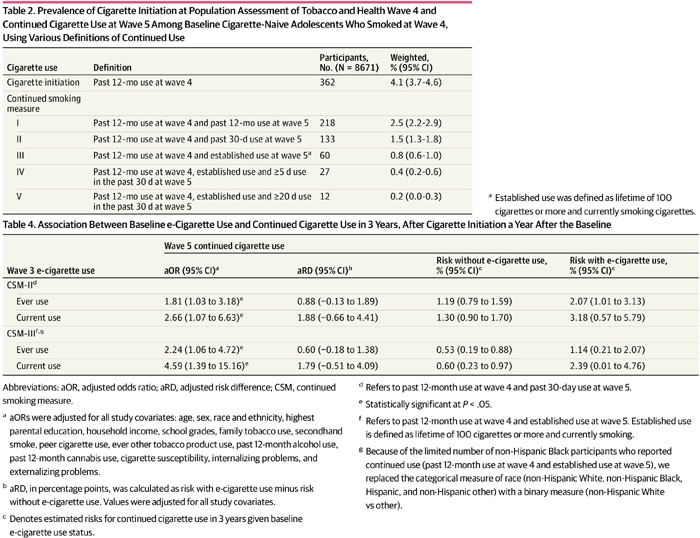An often cited myth is that using vapes is a gateway to starting cigarette smoking.

This has been disproved many times but another article on the Jama Network gives more proof that the gateway theory is not true.
The document is titled “e-Cigarette and Cigarette use among youth: Gateway or common liability?”
The article was authored by Cristine D Delnevo PhD, MPH of the Rutgers Center for Tobacco Studies, New Brunswick, New Jersey, USA.

Background
The first line of the article cites the 2018 report from the National Academy of Science, Engineering and Medicine which concluded that e-cigarette youth use is associated with increased risk of use of a cigarette.
This then provoked a swarm of public health interest assuming youth vaping would result in youth smoking.
Investigation
Another study is cited in Cristine’s article, titled “Association of Electronic Cigarette Use by US Adolescents With Subsequent Persistent Cigarette Smoking“, by Ruoyan Sun PhD, David Mendez PhD and Kenneth E Warner PhD – March 27th 2023.
The above mentioned study used data from the PATH (population Assessment on Tobacco Use and Health) study.
Apparently 8,671 youngsters who were “Cigarette-Naive” were studied from waves 3-5 (October 2015 to November 2019) of the survey.
The findings indicated that on the earlier wave 3, those who used e-cigarettes had higher odds of continued cigarette smoking.
The number of those who had smoked in the last 12 months at wave 4 was 362 (4.1%)
However by wave 5 the number of frequent smokers (defined as 20 or more days in the past 30 days) was so low (0.2%) that the authors could not model this outcome due to its rarity.
But they did model the possible 3 year smoking outcomes for…
- CSM (Cigarette Smoking Measure) band II (had smoked in past 12 months at wave 4 and had smoked in past 30 days at wave 5)
- CSM band III (had smoked in past 12 months at wave 4 and current smokers at wave 5).
For those who had ever used e-cigarettes (but not current vapers) the CMS II risk of continuing smoking for 3 years was 2.07% and 1.14% for band III.
Those who were current vapers their risk of continuing smoking for 3 years was 3.18% for band II and 2.39% for band III.
As you can see we are talking very small percentage differences.
“Although the significantly higher odds of continued smoking among e-cigarette users suggest a potentially important problem, the small magnitude of absolute risks and the minor risk differences in continued smoking between baseline e-cigarette users and nonusers indicate a much less consequential problem: few adolescents are likely to report continued smoking after initiation regardless of baseline e-cigarette use.”
These charts really hurt my brain with all of the possibly variables!
Basically there was a risk of moving from vaping to smoking but they are unlikely to continue smoking.
“our results show that many adolescents who initiated smoking did not report continued smoking 2 years later”
Cristine points out how in 2009 when vapes first came to the US, the cigarette smoking rates were 23.2%. However the 2022 NYTS (National Youth Tobacco Survey) data shows that e-cigarette use was at 14.1% of school aged youth whilst smoking rates had dropped to 2%.
“At the population level, e-cigarettes do not appear to be a gateway to cigarette smoking.”
“Collectively, concerns about a gateway effect and a potential increase in youth cigarette use following the introduction of e-cigarettes to the US market are not supported by the data. Moreover, future research and policy efforts should give more attention to the common liability theory and consider that in the context of a complex tobacco marketplace, increased diversity in the types of products, brands, and flavors fundamentally provides more opportunities for youths to experiment with tobacco and nicotine products.”
“While not explicitly explored in the study by Sun et al it is plausible that e-cigarettes were not the first tobacco product with which youths experimented.”
Reactions
The SMC (Science Media Centre) website has published a response from Lion Shahab – Professor of Health Psychology and Co-Director of the UCL (University College London) Tobacco and Alcohol research group.
He points out how this study does not compare results with young people who had never used an e-cigarette to see how the risk differs.
“Importantly, this study cannot tell us what adolescents that started using e-cigarettes would have done in the absence of e-cigarettes. It is conceivable that these youth would have started using cigarettes instead anyway, and at possibly much higher rates, had they not opted to use e-cigarettes instead.”
Also the fact that smoking rates have actually declined with the increase of vaping rates proves that although the data may show a small risk, in real life this situation does not appear to be playing out.
“adolescent smoking rates have continued to decline at the same that e-cigarette use by youth increased dramatically in the US.”
“This means that even though e-cigarettes relatively speaking are associated with later smoking compared with not using them, because so few adolescents start smoking, irrespective of their e-cigarettes use, at population level e-cigarette use will not have had a noticeable impact on smoking rates in absolute terms.”
Tweets
12–17-year-olds who use e-cigarettes are more likely to smoke cigarettes 2 years later than their non-vaping peers, but the absolute risk of adolescents continuing smoking is low. https://t.co/HwWMYzBc2Z
— JAMA Network Open (@JAMANetworkOpen) March 27, 2023
New study: Public health “has been preoccupied with e-cigarettes as a gateway to cigarette smoking among young people… [but subsequent] prevalence of frequent smoking …2 years later (wave 5) was so low (0.2%), the authors could not model it.”https://t.co/vVopYHNhj1
— Charles A. Gardner, PhD (@ChaunceyGardner) March 27, 2023
“The analysis…clearly points to very few youths reporting continued cigarette smoking regardless of baseline e-cigarette use. Collectively, concerns about a gateway effect and a potential increase in youth cigarette use…are not supported by the data.”https://t.co/xw3o0KpgrF pic.twitter.com/aXZBtDzBwk
— CASAA (@CASAAmedia) March 27, 2023
“At the population level, e-cigarettes do not appear to be a gateway to cigarette smoking.”
Why?
In HS-aged youth:
🔹2022 NYTS:
14.1% #eCig use, but also lowest rate of 🔥🚬 smoking (2.0%) ever recorded🔹2009, when eCigs appear @🇺🇸:
🔥🚬 was 23.2%❗️https://t.co/hBLbOoSbA3— Dr. Alexander K. Nussbaum (@NussbaumDr) March 27, 2023
And yet… The @WHO continues to say teens who vape nicotine are 2 times more likely to subsequently smoke. Other organizations continue to claim 3x, or 5x, or even 7x more likely to smoke.
And all of them are just, literally, making this up.
— Charles A. Gardner, PhD (@ChaunceyGardner) March 28, 2023
🔎🧐
Expert reactions are coming in on the JAMA Network paper. This one shatters the fundamental premise that @FDATobacco and prohibition zealots have been using to deprive millions of adult Americans of their fundamental right to access vaping products.https://t.co/alCbH5oda2 pic.twitter.com/sP4HnEWhDJ— American Vapor Manufacturers (@VaporAmerican) March 28, 2023
“At the population level, e-cigarettes don’t appear to be a gateway to cigarette smoking. […] Concerns about […] a potential increase in youth cigarette use following the introduction of e-cigarettes to the US market aren’t supported by the data.”https://t.co/jHkMkvHiDW
— The Global State of Tobacco Harm Reduction (@GlobalStateTHR) March 29, 2023







